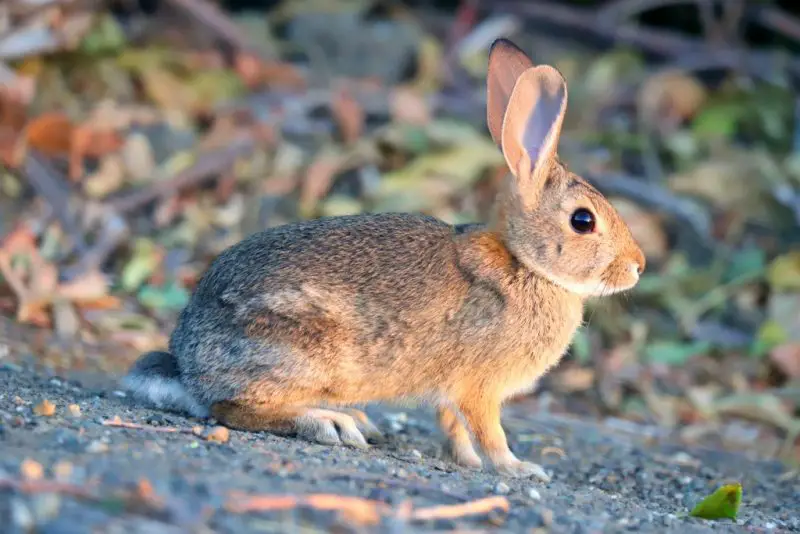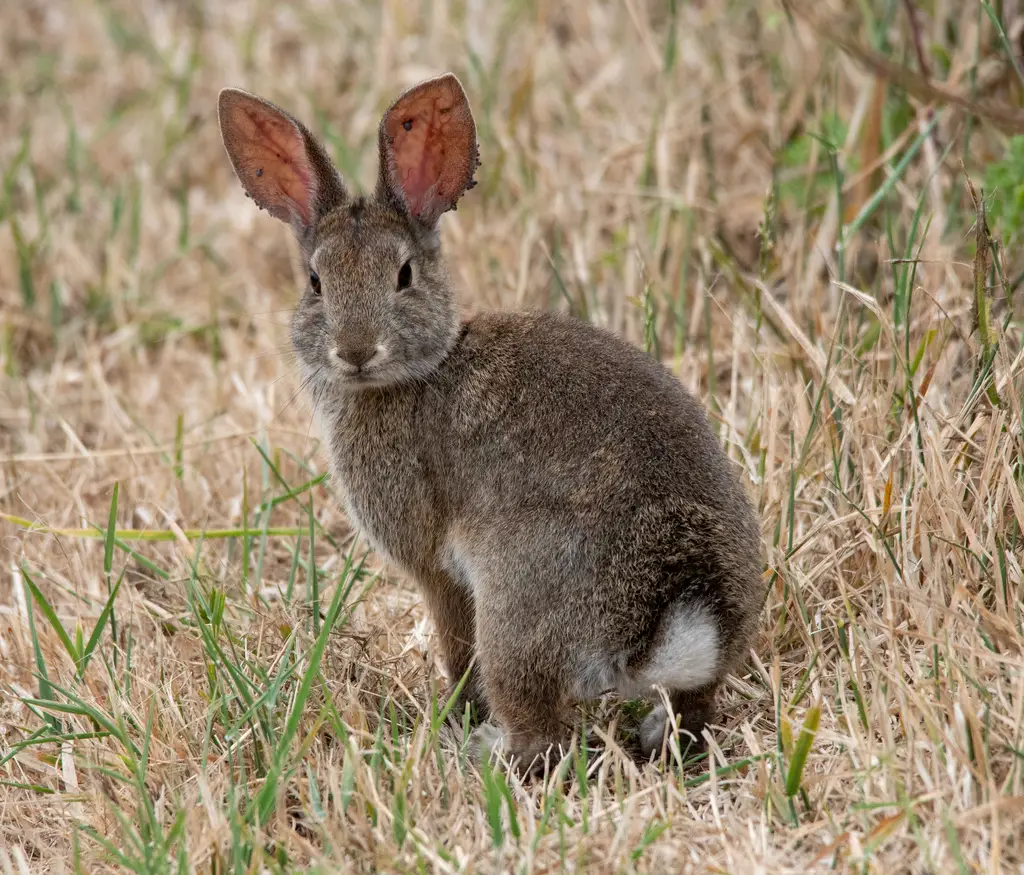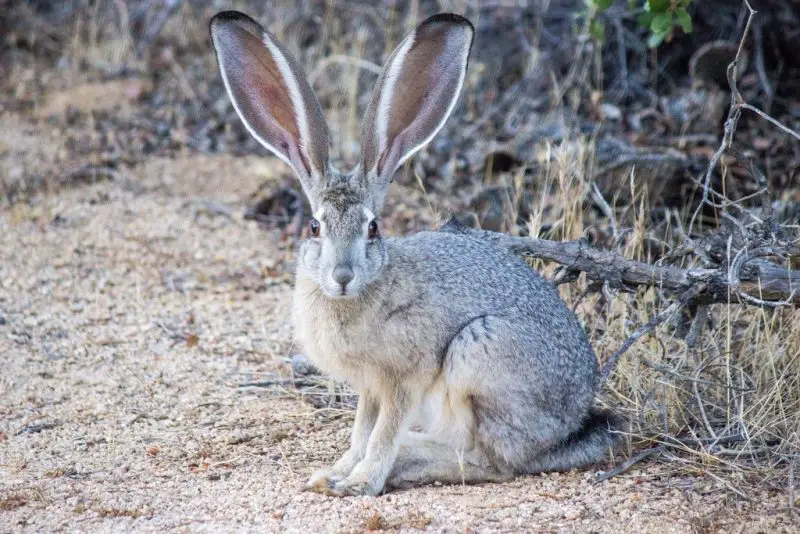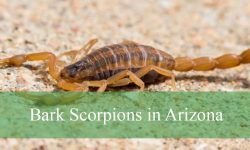Wild rabbits are a common sight across California’s varied landscapes—from sunbaked deserts and grassy plains to coastal hills and chaparral thickets. These animals are more than just quick glimpses of fur; they’re an important part of the ecosystem and can reveal a lot about the health of their surroundings.
This article highlights three wild rabbit species found throughout the state: the Desert Cottontail, the Brush Rabbit, and the Black-tailed Jackrabbit. Each species has distinct traits, behaviors, and habitat preferences that make it easy to identify if you know what to look for. With photos and detailed descriptions, you’ll learn how to recognize them in the wild.
Exploring the lives of these rabbits offers insight into how they survive, reproduce, and adapt to California’s unique environments. From thick brush to open deserts, these wild rabbits have found ways to thrive in surprising places.
Common Wild Rabbits Found in California
Desert Cottontail (Sylvilagus audubonii)

The Desert Cottontail is one of the most commonly seen wild rabbits in California and throughout the American West. It is named for its distinctive white, fluffy tail that resembles a ball of cotton. This species has soft, grayish-tan fur, a pale belly, and relatively large ears that help dissipate heat. Adult Desert Cottontails usually measure between 12 to 16 inches in length and weigh between 2 to 3 pounds. Their large eyes and excellent hearing give them an advantage in detecting predators in open environments.
These rabbits are crepuscular, meaning they are most active during early morning and late evening hours. During the heat of the day, they take cover in shallow scrapes under vegetation or in the shade of rocks and shrubs. When startled, they often flee in a zigzag pattern to confuse predators like hawks, coyotes, and snakes. Despite being solitary creatures, Desert Cottontails may sometimes be seen feeding in groups in resource-rich areas. They are not territorial and can have overlapping home ranges.
Desert Cottontails primarily feed on grasses, forbs, and the leaves of shrubs such as mesquite and sagebrush. In drier months, they may also consume cactus pads and bark. They can survive long periods without free-standing water by extracting moisture from their food. Breeding season in California extends from early spring through late summer. Females build shallow nests lined with fur and grasses, and they can produce multiple litters per year, each containing 2 to 6 young.
This species is found throughout California except at high elevations. It thrives in arid and semi-arid regions such as the Mojave Desert, Central Valley, and foothills, as well as open grassy areas and even suburban landscapes. A fun fact: Desert Cottontails do not dig their own burrows like some other rabbits—they rely on natural cover or abandoned animal burrows for shelter. Their adaptability makes them a resilient and widespread species in the state.
Brush Rabbit (Sylvilagus bachmani)

The Brush Rabbit is a small, shy rabbit native to the western coastal and foothill regions of California. It has a compact body, short ears, and a short tail, typically darker in color than the Desert Cottontail. Its fur is a mix of dark gray and brown with a more uniform tone, helping it blend seamlessly into the dense brush it inhabits. Adults usually measure between 12 to 14 inches in length and weigh around 1.5 to 2 pounds, making it slightly smaller than its desert cousin.
Unlike other rabbits that prefer open areas, the Brush Rabbit depends heavily on dense vegetation such as chaparral, thickets, and bramble patches for cover and nesting. It is most commonly seen at dawn and dusk when it emerges from hiding to feed. Brush Rabbits are extremely wary and rarely venture far from shelter. When threatened, they may freeze to avoid detection or make short, rapid dashes back into cover. They are less likely to hop in long bounds like jackrabbits, favoring quick zigzagging sprints instead.
Their diet includes a wide range of leafy plants, grasses, and berries, and they are known to browse on twigs and bark during the winter. These rabbits breed from late winter to early fall in California, with the peak occurring in spring. A female may have several litters annually, with each litter producing 2 to 5 young. Nests are usually built in hidden spots under dense vegetation and are lined with the mother’s fur.
Brush Rabbits are found along the coastal ranges, including the Santa Cruz Mountains, Bay Area, and throughout the Sierra Nevada foothills. They are rarely seen in urban settings due to their strong preference for wild, brushy environments. A fun fact: Brush Rabbits are the only cottontail species in California known to be susceptible to the rabbit hemorrhagic disease virus (RHDV2), a recent threat to wild and domestic rabbit populations in the state.
Black-tailed Jackrabbit (Lepus californicus)

The Black-tailed Jackrabbit is not a true rabbit but a species of hare, and it is the largest lagomorph commonly found in California. It is easily recognized by its long, powerful hind legs, enormous ears, and black-tipped tail. Its fur is generally a mottled brownish-gray, providing effective camouflage in dry, open landscapes. Adults can reach 18 to 24 inches in length and weigh 3 to 6 pounds. Their large ears help regulate body temperature in hot climates and also enhance hearing.
These hares are primarily nocturnal and crepuscular, though they may be active during cooler parts of the day. Unlike rabbits, jackrabbits are built for speed and can run up to 40 mph in short bursts to escape predators. They rely on their incredible agility and keen senses to survive in open terrain. Black-tailed Jackrabbits are solitary animals, except during mating season or when females are caring for their young. They don’t dig burrows but rest in shallow depressions called “forms” during the day.
Their diet consists of tough, fibrous vegetation such as sagebrush, mesquite, grasses, and cactus. They are well adapted to arid environments and can meet their moisture needs entirely from their food. Breeding occurs year-round in California, especially in warmer regions. Females may produce up to four litters per year, with 1 to 6 leverets per litter. Unlike rabbit kits, jackrabbit young are born fully furred and with eyes open, ready to move shortly after birth.
Black-tailed Jackrabbits are widespread throughout the Central Valley, deserts (such as the Mojave and Colorado), foothills, and even in agricultural zones where crops offer easy foraging. They avoid heavily forested areas and dense urban zones. A fun fact: their long ears aren’t just for cooling and hearing—they can also display subtle movements that communicate mood or alertness to nearby jackrabbits. These remarkable hares are a familiar sight dashing across roads and fields in many parts of California.
FAQs About Wild Rabbits in California
What types of wild rabbits live in California?
California is home to several wild rabbit species, including the Desert Cottontail, Brush Rabbit, and the Black-tailed Jackrabbit (a species of hare). Each has unique physical traits and prefers different habitats across the state.
Where are wild rabbits most commonly found in California?
Wild rabbits are widespread throughout the state. Desert Cottontails thrive in open areas like deserts, grasslands, and suburban edges. Brush Rabbits prefer dense shrublands and coastal foothills, while Black-tailed Jackrabbits are commonly seen in dry valleys, deserts, and agricultural zones.
What do wild rabbits in California eat?
Their diet mainly consists of grasses, herbs, shrubs, and twigs. Desert Cottontails and Brush Rabbits feed on leafy plants and bark, while Black-tailed Jackrabbits consume tougher vegetation like sagebrush, cactus, and desert shrubs.
Are wild rabbits dangerous or aggressive?
No, wild rabbits in California are non-aggressive and naturally shy. They flee from humans and predators quickly. However, like all wildlife, they should not be approached or handled to avoid potential disease transmission.
Do wild rabbits dig burrows?
Desert Cottontails and Brush Rabbits usually do not dig deep burrows. They rely on vegetation, rocks, or shallow scrapes for shelter. In contrast, hares like the Black-tailed Jackrabbit rest in shallow depressions called “forms.”
When is breeding season for wild rabbits in California?
Breeding typically begins in early spring and can extend into late summer or early fall. Thanks to California’s mild climate, some species may breed year-round in warmer regions. Females often have multiple litters per year.
Are wild rabbits protected in California?
Wild rabbits are considered nongame mammals under California law, meaning they can be taken or hunted during certain seasons with proper licenses. However, local regulations and land use rules may restrict hunting or trapping.
What predators do wild rabbits face in California?
Common predators include hawks, coyotes, bobcats, foxes, snakes, and owls. Young rabbits are especially vulnerable. Their speed, camouflage, and use of dense vegetation help them evade these threats.
How can I tell the difference between a rabbit and a jackrabbit?
Jackrabbits are larger, with longer legs and ears. They are hares, not true rabbits, and their young are born with fur and open eyes. Cottontails and Brush Rabbits are smaller and rounder, with shorter ears and tails.
What should I do if I find a baby wild rabbit?
If the rabbit is uninjured and in a natural area, it’s best to leave it alone. Mothers often leave their young hidden while they feed. If the rabbit appears injured or orphaned, contact a licensed wildlife rehabilitator for guidance.






